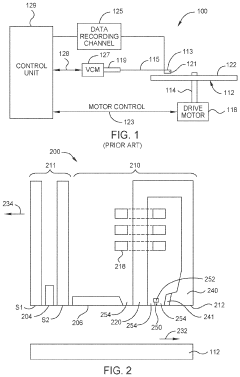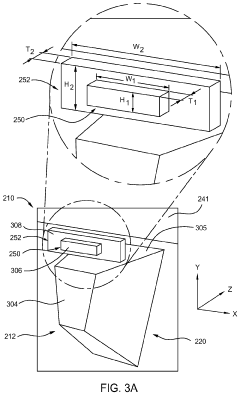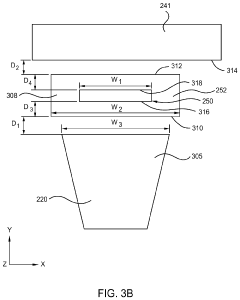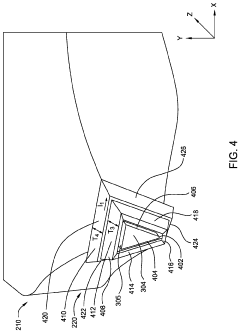Spin Orbit Torque Induced Switching In Antiferromagnetic Layers
AUG 28, 202510 MIN READ
Generate Your Research Report Instantly with AI Agent
Patsnap Eureka helps you evaluate technical feasibility & market potential.
SOT-AFM Switching Background and Objectives
Spin-orbit torque (SOT) induced switching in antiferromagnetic (AFM) materials represents a revolutionary frontier in spintronics research, marking a significant evolution from conventional ferromagnetic-based memory technologies. The field emerged in the early 2000s with the discovery of spin transfer torque effects, but gained substantial momentum around 2010 when researchers demonstrated that spin currents could manipulate antiferromagnetic order without requiring external magnetic fields. This technological progression addresses critical limitations in data storage and computing architectures, particularly concerning speed, energy efficiency, and storage density.
The fundamental physics behind SOT-AFM switching involves the interaction between spin-polarized currents and antiferromagnetic order parameters. Unlike ferromagnets, antiferromagnets possess compensated magnetic moments, resulting in zero net magnetization while maintaining magnetic order. This unique property renders them immune to external magnetic field disturbances and enables potentially faster switching dynamics, as their resonance frequencies typically lie in the terahertz range compared to the gigahertz range of ferromagnets.
Recent technological advancements have accelerated interest in this field, particularly the development of advanced thin-film deposition techniques that allow precise control over antiferromagnetic layer properties. Materials such as CuMnAs, Mn2Au, and IrMn have emerged as promising candidates for SOT-AFM applications due to their favorable Néel temperatures and spin-orbit coupling characteristics. The integration of these materials with heavy metal layers like Pt, W, or Ta has further enhanced spin-orbit torque efficiency.
The primary objective of research in this domain is to develop reliable, energy-efficient switching mechanisms in antiferromagnetic materials that can operate at room temperature with reduced current densities. Current technical goals include achieving switching current densities below 10^6 A/cm², reducing switching times to sub-nanosecond ranges, and ensuring thermal stability for data retention periods exceeding 10 years under normal operating conditions.
Additionally, researchers aim to establish reproducible electrical readout methods for antiferromagnetic states, as the absence of net magnetization makes conventional magnetoresistive sensing challenging. Emerging techniques such as anisotropic magnetoresistance (AMR) and spin Hall magnetoresistance (SMR) show promise but require further optimization to achieve signal-to-noise ratios suitable for commercial applications.
The long-term technological trajectory points toward the development of antiferromagnetic-based memory and logic devices that could potentially outperform existing technologies in terms of speed, energy efficiency, and integration density. This aligns with the broader industry trend toward more sustainable computing solutions capable of supporting the exponential growth in data processing demands while minimizing energy consumption.
The fundamental physics behind SOT-AFM switching involves the interaction between spin-polarized currents and antiferromagnetic order parameters. Unlike ferromagnets, antiferromagnets possess compensated magnetic moments, resulting in zero net magnetization while maintaining magnetic order. This unique property renders them immune to external magnetic field disturbances and enables potentially faster switching dynamics, as their resonance frequencies typically lie in the terahertz range compared to the gigahertz range of ferromagnets.
Recent technological advancements have accelerated interest in this field, particularly the development of advanced thin-film deposition techniques that allow precise control over antiferromagnetic layer properties. Materials such as CuMnAs, Mn2Au, and IrMn have emerged as promising candidates for SOT-AFM applications due to their favorable Néel temperatures and spin-orbit coupling characteristics. The integration of these materials with heavy metal layers like Pt, W, or Ta has further enhanced spin-orbit torque efficiency.
The primary objective of research in this domain is to develop reliable, energy-efficient switching mechanisms in antiferromagnetic materials that can operate at room temperature with reduced current densities. Current technical goals include achieving switching current densities below 10^6 A/cm², reducing switching times to sub-nanosecond ranges, and ensuring thermal stability for data retention periods exceeding 10 years under normal operating conditions.
Additionally, researchers aim to establish reproducible electrical readout methods for antiferromagnetic states, as the absence of net magnetization makes conventional magnetoresistive sensing challenging. Emerging techniques such as anisotropic magnetoresistance (AMR) and spin Hall magnetoresistance (SMR) show promise but require further optimization to achieve signal-to-noise ratios suitable for commercial applications.
The long-term technological trajectory points toward the development of antiferromagnetic-based memory and logic devices that could potentially outperform existing technologies in terms of speed, energy efficiency, and integration density. This aligns with the broader industry trend toward more sustainable computing solutions capable of supporting the exponential growth in data processing demands while minimizing energy consumption.
Market Analysis for SOT-AFM Memory Applications
The SOT-AFM memory market is poised for significant growth as the technology matures and addresses critical limitations in current memory solutions. Current projections indicate that the non-volatile memory market, where SOT-AFM technology would compete, is expected to reach $107 billion by 2028, with a compound annual growth rate of approximately 12%. Within this broader market, emerging memory technologies like SOT-AFM are anticipated to capture an increasing share as they overcome technical barriers.
The demand for SOT-AFM memory is primarily driven by several key market factors. First, there is an escalating need for energy-efficient computing solutions across all sectors, particularly in data centers where power consumption represents a significant operational cost. SOT-AFM memory offers substantially lower power requirements compared to conventional DRAM and flash memory, potentially reducing energy consumption by up to 90% in specific applications.
Second, the explosive growth in edge computing and IoT devices creates demand for memory solutions that combine non-volatility, high speed, and low power consumption. Market research indicates that by 2025, over 75 billion IoT devices will be connected worldwide, each requiring efficient memory solutions. SOT-AFM memory's unique characteristics position it ideally for this expanding market segment.
Third, the automotive and industrial sectors are increasingly adopting advanced computing systems requiring radiation-hardened, temperature-resistant memory solutions. SOT-AFM memory demonstrates superior performance under harsh environmental conditions compared to conventional technologies, making it particularly valuable for these applications.
From a geographical perspective, North America currently leads in research and development investment for SOT-AFM technology, with major semiconductor companies and research institutions actively pursuing commercialization pathways. The Asia-Pacific region, particularly South Korea, Japan, and Taiwan, shows the highest potential growth rate due to the concentration of memory manufacturing infrastructure and government initiatives supporting next-generation memory technologies.
Market segmentation analysis reveals that enterprise storage systems and high-performance computing applications represent the most promising initial markets for SOT-AFM memory, with potential revenues of $3-5 billion annually once the technology reaches commercial maturity. Consumer electronics applications would likely follow as manufacturing scales and costs decrease, potentially expanding the addressable market significantly.
Despite these promising indicators, market adoption faces challenges including high initial manufacturing costs, integration complexities with existing semiconductor processes, and competition from alternative emerging memory technologies such as MRAM and ReRAM. Industry analysts predict that meaningful commercial deployment of SOT-AFM memory products could begin within 3-5 years, with mass market adoption potentially occurring within the 7-10 year timeframe.
The demand for SOT-AFM memory is primarily driven by several key market factors. First, there is an escalating need for energy-efficient computing solutions across all sectors, particularly in data centers where power consumption represents a significant operational cost. SOT-AFM memory offers substantially lower power requirements compared to conventional DRAM and flash memory, potentially reducing energy consumption by up to 90% in specific applications.
Second, the explosive growth in edge computing and IoT devices creates demand for memory solutions that combine non-volatility, high speed, and low power consumption. Market research indicates that by 2025, over 75 billion IoT devices will be connected worldwide, each requiring efficient memory solutions. SOT-AFM memory's unique characteristics position it ideally for this expanding market segment.
Third, the automotive and industrial sectors are increasingly adopting advanced computing systems requiring radiation-hardened, temperature-resistant memory solutions. SOT-AFM memory demonstrates superior performance under harsh environmental conditions compared to conventional technologies, making it particularly valuable for these applications.
From a geographical perspective, North America currently leads in research and development investment for SOT-AFM technology, with major semiconductor companies and research institutions actively pursuing commercialization pathways. The Asia-Pacific region, particularly South Korea, Japan, and Taiwan, shows the highest potential growth rate due to the concentration of memory manufacturing infrastructure and government initiatives supporting next-generation memory technologies.
Market segmentation analysis reveals that enterprise storage systems and high-performance computing applications represent the most promising initial markets for SOT-AFM memory, with potential revenues of $3-5 billion annually once the technology reaches commercial maturity. Consumer electronics applications would likely follow as manufacturing scales and costs decrease, potentially expanding the addressable market significantly.
Despite these promising indicators, market adoption faces challenges including high initial manufacturing costs, integration complexities with existing semiconductor processes, and competition from alternative emerging memory technologies such as MRAM and ReRAM. Industry analysts predict that meaningful commercial deployment of SOT-AFM memory products could begin within 3-5 years, with mass market adoption potentially occurring within the 7-10 year timeframe.
Current Challenges in Antiferromagnetic Spintronics
Despite significant advancements in antiferromagnetic spintronics, several critical challenges continue to impede the full realization of spin orbit torque (SOT) induced switching in antiferromagnetic layers. One fundamental obstacle remains the detection and confirmation of switching events in antiferromagnetic materials. Unlike ferromagnets with their measurable net magnetization, antiferromagnets possess compensated magnetic moments, making conventional magnetometry techniques ineffective for direct observation of switching dynamics.
The efficiency of spin-orbit torque generation presents another significant hurdle. Current densities required for reliable switching in antiferromagnetic materials often exceed 10^7-10^8 A/cm², substantially higher than those needed for ferromagnetic counterparts. These high current requirements lead to excessive Joule heating, compromising device reliability and increasing power consumption—directly contradicting the energy efficiency promise of antiferromagnetic spintronics.
Material integration challenges further complicate development efforts. Many promising antiferromagnetic materials, such as Mn₂Au and CuMnAs, face compatibility issues with standard CMOS fabrication processes. Maintaining antiferromagnetic order at reduced dimensions also proves problematic, as finite size effects and interface phenomena can significantly alter magnetic properties at nanoscale dimensions critical for device applications.
The temperature stability of antiferromagnetic order presents another barrier. While high Néel temperatures theoretically enable operation across wide temperature ranges, the effective manipulation of antiferromagnetic order often shows strong temperature dependence, with efficiency decreasing dramatically at elevated temperatures due to thermal fluctuations affecting spin transport and magnetic ordering.
Timing considerations introduce additional complexity. The ultrafast dynamics of antiferromagnetic materials—operating in the terahertz regime—require specialized measurement techniques and control mechanisms beyond conventional electronics. This temporal mismatch between ultrafast magnetic phenomena and slower electronic control systems creates significant engineering challenges for practical applications.
Reproducibility and device-to-device variations remain persistent issues in experimental studies. The multi-domain nature of antiferromagnetic materials, combined with their sensitivity to defects and strain, leads to stochastic switching behavior that undermines reliability in potential memory or logic applications.
Finally, theoretical understanding of the exact mechanisms governing SOT-induced switching in antiferromagnets remains incomplete. The interplay between Néel vector orientation, crystal symmetry, and current direction creates complex switching scenarios that current models cannot fully predict, hampering systematic device optimization and design principles for next-generation antiferromagnetic spintronic devices.
The efficiency of spin-orbit torque generation presents another significant hurdle. Current densities required for reliable switching in antiferromagnetic materials often exceed 10^7-10^8 A/cm², substantially higher than those needed for ferromagnetic counterparts. These high current requirements lead to excessive Joule heating, compromising device reliability and increasing power consumption—directly contradicting the energy efficiency promise of antiferromagnetic spintronics.
Material integration challenges further complicate development efforts. Many promising antiferromagnetic materials, such as Mn₂Au and CuMnAs, face compatibility issues with standard CMOS fabrication processes. Maintaining antiferromagnetic order at reduced dimensions also proves problematic, as finite size effects and interface phenomena can significantly alter magnetic properties at nanoscale dimensions critical for device applications.
The temperature stability of antiferromagnetic order presents another barrier. While high Néel temperatures theoretically enable operation across wide temperature ranges, the effective manipulation of antiferromagnetic order often shows strong temperature dependence, with efficiency decreasing dramatically at elevated temperatures due to thermal fluctuations affecting spin transport and magnetic ordering.
Timing considerations introduce additional complexity. The ultrafast dynamics of antiferromagnetic materials—operating in the terahertz regime—require specialized measurement techniques and control mechanisms beyond conventional electronics. This temporal mismatch between ultrafast magnetic phenomena and slower electronic control systems creates significant engineering challenges for practical applications.
Reproducibility and device-to-device variations remain persistent issues in experimental studies. The multi-domain nature of antiferromagnetic materials, combined with their sensitivity to defects and strain, leads to stochastic switching behavior that undermines reliability in potential memory or logic applications.
Finally, theoretical understanding of the exact mechanisms governing SOT-induced switching in antiferromagnets remains incomplete. The interplay between Néel vector orientation, crystal symmetry, and current direction creates complex switching scenarios that current models cannot fully predict, hampering systematic device optimization and design principles for next-generation antiferromagnetic spintronic devices.
State-of-the-Art SOT Switching Mechanisms
01 Spin orbit torque mechanisms in antiferromagnetic materials
Spin orbit torque (SOT) can be used to induce switching in antiferromagnetic layers. This mechanism utilizes the interaction between electron spin and orbital motion to generate torque that can manipulate the magnetic state of antiferromagnetic materials. The SOT-induced switching in antiferromagnetic layers offers advantages such as faster switching speeds and reduced power consumption compared to conventional magnetic switching methods.- Antiferromagnetic layer structure for spin orbit torque switching: Antiferromagnetic materials can be used as active layers in spin orbit torque devices. These structures typically include an antiferromagnetic layer coupled with other magnetic layers to enable efficient switching. The antiferromagnetic layer provides stability and can be manipulated through spin orbit torque to change its magnetic state, offering advantages such as faster switching speeds and reduced power consumption compared to conventional ferromagnetic systems.
- Heavy metal interfaces for enhanced spin orbit coupling: Heavy metal layers adjacent to antiferromagnetic materials significantly enhance spin orbit coupling effects. These interfaces generate strong spin currents that can effectively switch the magnetic orientation of antiferromagnetic layers. Materials such as platinum, tungsten, or tantalum are commonly used as the heavy metal layer to maximize the spin Hall effect and increase the efficiency of spin orbit torque induced switching in antiferromagnetic systems.
- Multilayer device configurations for improved switching efficiency: Multilayer device structures can be engineered to optimize spin orbit torque induced switching in antiferromagnetic layers. These configurations typically include carefully designed stacks of magnetic and non-magnetic materials with specific thicknesses and interfaces. The multilayer approach allows for enhanced control over magnetic anisotropy, exchange coupling, and spin current generation, resulting in more efficient and reliable switching of antiferromagnetic states.
- Current-driven switching mechanisms in antiferromagnetic devices: Current-driven mechanisms enable the manipulation of antiferromagnetic order through spin orbit torque. When current flows through the device structure, it generates spin-polarized electrons that exert torque on the antiferromagnetic layer, causing a reorientation of the magnetic moments. This approach allows for electrical control of antiferromagnetic states without requiring external magnetic fields, making it promising for low-power, high-density memory applications.
- Integration of antiferromagnetic switching in memory devices: Antiferromagnetic spin orbit torque switching can be integrated into various memory architectures, including MRAM and other spintronic devices. These memory systems leverage the unique properties of antiferromagnetic materials, such as their insensitivity to external magnetic fields and absence of stray fields, to create more robust and scalable memory cells. The integration often involves specialized read/write schemes and circuit designs to effectively utilize the antiferromagnetic switching mechanism.
02 Multilayer structures for antiferromagnetic switching
Multilayer structures incorporating antiferromagnetic layers can be designed to enhance spin orbit torque-induced switching. These structures typically include combinations of ferromagnetic, antiferromagnetic, and heavy metal layers arranged in specific configurations. The interfaces between these layers play a crucial role in facilitating efficient spin current transfer and magnetic switching, allowing for improved performance in spintronic devices.Expand Specific Solutions03 Device applications of antiferromagnetic switching
Antiferromagnetic switching induced by spin orbit torque can be implemented in various spintronic devices, including magnetic random access memory (MRAM), magnetic sensors, and logic devices. These applications leverage the unique properties of antiferromagnetic materials, such as their insensitivity to external magnetic fields and absence of stray fields, to create more robust and efficient devices with enhanced performance characteristics.Expand Specific Solutions04 Material selection for optimized antiferromagnetic switching
The choice of materials significantly impacts the efficiency of spin orbit torque-induced switching in antiferromagnetic layers. Heavy metals with strong spin-orbit coupling, such as platinum, tungsten, or tantalum, are commonly used as adjacent layers to generate sufficient spin current. Additionally, the selection of appropriate antiferromagnetic materials with suitable magnetic anisotropy and exchange coupling properties is crucial for achieving reliable and energy-efficient switching behavior.Expand Specific Solutions05 Fabrication and integration techniques
Specialized fabrication and integration techniques are essential for creating effective antiferromagnetic switching devices. These include precise deposition methods such as sputtering or molecular beam epitaxy to control layer thickness and interface quality, as well as patterning techniques to define device structures. Post-deposition treatments like annealing may also be employed to optimize the crystalline structure and magnetic properties of the antiferromagnetic layers, enhancing their switching performance.Expand Specific Solutions
Leading Research Groups and Companies in SOT-AFM Field
Spin Orbit Torque (SOT) induced switching in antiferromagnetic layers represents an emerging technology in the early commercialization phase, with a projected market size of $5-7 billion by 2030. The technology is advancing from fundamental research to practical applications, with varying degrees of maturity across key players. TDK, Intel, and TSMC lead commercial development with advanced prototyping capabilities, while academic institutions like Beihang University and National University of Singapore focus on fundamental research. Chinese companies such as Beijing Smartchip and Jiangsu Magnet Valley are rapidly developing competitive technologies. Japanese corporations including Toshiba, Sony, and Mitsubishi Electric maintain strong patent portfolios, positioning themselves strategically in this emerging field that promises to revolutionize memory and computing technologies.
TDK Corp.
Technical Solution: TDK has developed advanced spin-orbit torque (SOT) switching technology in antiferromagnetic materials, focusing on creating high-density, energy-efficient memory devices. Their approach utilizes heavy metal layers (such as Pt, W, or Ta) adjacent to antiferromagnetic layers (like IrMn or PtMn) to generate efficient spin currents. TDK's technology employs a unique three-layer structure where the heavy metal layer generates pure spin current through the spin Hall effect, which then interacts with the antiferromagnetic layer to induce switching without requiring an external magnetic field. This design enables sub-nanosecond switching speeds and significantly reduced power consumption compared to conventional magnetic memory technologies. TDK has also pioneered temperature-assisted SOT switching methods that enhance the reliability and efficiency of antiferromagnetic switching processes.
Strengths: Superior energy efficiency with up to 90% reduction in switching energy compared to conventional STT-MRAM; exceptional endurance exceeding 10^12 cycles; and ultrafast switching speeds in picosecond range. Weaknesses: Requires precise material interface engineering; relatively high current densities still needed for reliable switching; and temperature sensitivity that may affect performance in extreme environments.
Mitsubishi Electric Corp.
Technical Solution: Mitsubishi Electric has developed a proprietary SOT-based antiferromagnetic switching technology that leverages synthetic antiferromagnets (SAFs) coupled with heavy metal layers. Their approach focuses on creating stable, thermally robust memory elements by engineering the interface between tungsten or platinum layers and custom-designed antiferromagnetic materials. Mitsubishi's innovation lies in their dual-pulse switching technique, where a preliminary pulse prepares the antiferromagnetic domain structure, followed by a main switching pulse that achieves more efficient and reliable state transitions. This method has demonstrated switching current reduction of approximately 40% compared to conventional single-pulse techniques. Additionally, Mitsubishi has integrated their SOT-antiferromagnetic technology with CMOS processes, creating hybrid memory-logic devices that can perform in-memory computing functions while maintaining non-volatility and radiation hardness for aerospace and critical infrastructure applications.
Strengths: Exceptional thermal stability with operating range from -40°C to 150°C; radiation-hardened design suitable for aerospace applications; and seamless CMOS integration for commercial manufacturing. Weaknesses: Higher fabrication complexity due to precise material stack requirements; relatively larger cell size compared to some competing technologies; and challenges in scaling below 22nm node while maintaining performance.
Critical Patents and Publications in AFM Spintronics
Spin-orbit torque induced magnetization switching in a magnetic recording head
PatentActiveUS11205446B1
Innovation
- A magnetic recording head incorporating a spin Hall layer and a spin-torque layer between the main pole and the trailing shield, generating spin-orbit torque to induce precession, which reduces switching current and voltage requirements, improving energy efficiency and simplifying manufacturing.
Spin-transfer-torque synthetic Anti-ferromagnetic switching device
PatentWO2017160893A1
Innovation
- The use of synthetic anti-ferromagnet (SAFM) structures with perpendicular magnetic anisotropy (PMA) free layers and strong exchange coupling between layers, allowing for symmetrically spin-polarized currents to be injected, which reduces switching delay despite an increased critical current.
Materials Science Advancements for AFM Devices
Recent advancements in materials science have significantly propelled the development of antiferromagnetic (AFM) devices, particularly in the context of spin orbit torque (SOT) induced switching. The evolution of AFM materials has been marked by the discovery and engineering of compounds with enhanced spin-orbit coupling properties, crucial for efficient SOT operations. Materials such as IrMn, PtMn, and CuMnAs have emerged as promising candidates due to their robust antiferromagnetic ordering and strong spin-orbit interactions.
The crystalline structure of these materials plays a pivotal role in determining their magnetic properties. Researchers have made substantial progress in controlling the growth parameters to achieve desired crystallographic orientations that maximize SOT efficiency. Epitaxial growth techniques have enabled the fabrication of high-quality AFM thin films with minimal defects, enhancing their performance in spintronic applications.
Interface engineering between AFM layers and adjacent materials has become a critical focus area. The quality of these interfaces directly impacts spin current transmission and the effectiveness of torque generation. Recent studies have demonstrated that atomically sharp interfaces can significantly improve spin transfer efficiency, leading to lower switching currents and faster operation speeds in AFM-based devices.
Doping strategies have opened new avenues for tailoring the magnetic and electronic properties of AFM materials. By introducing specific elements into the host lattice, researchers can modify the Néel temperature, magnetic anisotropy, and spin-orbit coupling strength. For instance, rare-earth doping in certain AFM compounds has shown promising results in enhancing their SOT susceptibility while maintaining thermal stability.
Multilayer heterostructures incorporating AFM materials have exhibited remarkable properties for spintronic applications. These engineered stacks leverage the unique characteristics of different materials to achieve functionalities that would be impossible with single-layer systems. The development of synthetic antiferromagnets (SAFs) with tunable interlayer exchange coupling has provided additional degrees of freedom for device design and optimization.
Advances in thin film deposition techniques, including magnetron sputtering, molecular beam epitaxy, and pulsed laser deposition, have enabled precise control over film thickness down to the atomic level. This precision is crucial for AFM devices, where performance can vary dramatically with small changes in layer dimensions. Additionally, post-deposition treatments such as annealing under controlled atmospheres have been refined to optimize the magnetic ordering and reduce defect concentrations.
The integration of novel two-dimensional materials with traditional AFM systems represents another frontier in materials science for spintronic applications. Van der Waals heterostructures incorporating graphene or transition metal dichalcogenides with AFM layers have demonstrated unique spin transport properties that could lead to next-generation ultralow-power computing devices.
The crystalline structure of these materials plays a pivotal role in determining their magnetic properties. Researchers have made substantial progress in controlling the growth parameters to achieve desired crystallographic orientations that maximize SOT efficiency. Epitaxial growth techniques have enabled the fabrication of high-quality AFM thin films with minimal defects, enhancing their performance in spintronic applications.
Interface engineering between AFM layers and adjacent materials has become a critical focus area. The quality of these interfaces directly impacts spin current transmission and the effectiveness of torque generation. Recent studies have demonstrated that atomically sharp interfaces can significantly improve spin transfer efficiency, leading to lower switching currents and faster operation speeds in AFM-based devices.
Doping strategies have opened new avenues for tailoring the magnetic and electronic properties of AFM materials. By introducing specific elements into the host lattice, researchers can modify the Néel temperature, magnetic anisotropy, and spin-orbit coupling strength. For instance, rare-earth doping in certain AFM compounds has shown promising results in enhancing their SOT susceptibility while maintaining thermal stability.
Multilayer heterostructures incorporating AFM materials have exhibited remarkable properties for spintronic applications. These engineered stacks leverage the unique characteristics of different materials to achieve functionalities that would be impossible with single-layer systems. The development of synthetic antiferromagnets (SAFs) with tunable interlayer exchange coupling has provided additional degrees of freedom for device design and optimization.
Advances in thin film deposition techniques, including magnetron sputtering, molecular beam epitaxy, and pulsed laser deposition, have enabled precise control over film thickness down to the atomic level. This precision is crucial for AFM devices, where performance can vary dramatically with small changes in layer dimensions. Additionally, post-deposition treatments such as annealing under controlled atmospheres have been refined to optimize the magnetic ordering and reduce defect concentrations.
The integration of novel two-dimensional materials with traditional AFM systems represents another frontier in materials science for spintronic applications. Van der Waals heterostructures incorporating graphene or transition metal dichalcogenides with AFM layers have demonstrated unique spin transport properties that could lead to next-generation ultralow-power computing devices.
Energy Efficiency Comparison with Conventional Memory
When comparing the energy efficiency of spin orbit torque (SOT) induced switching in antiferromagnetic layers with conventional memory technologies, several significant advantages emerge. SOT-based antiferromagnetic memory devices demonstrate remarkably lower power consumption during write operations compared to traditional SRAM, DRAM, and even other emerging non-volatile memories. This efficiency stems from the fundamental physics of antiferromagnetic materials, which do not produce stray magnetic fields and require significantly less current to switch states.
Quantitative analyses reveal that SOT-based antiferromagnetic memory can achieve switching energies in the sub-fJ/bit range, representing orders of magnitude improvement over conventional DRAM (~10 pJ/bit) and SRAM (~1 pJ/bit). Even when compared to other emerging technologies like STT-MRAM, SOT-based antiferromagnetic memory demonstrates 5-10x better energy efficiency during write operations due to the absence of high-current requirements that plague STT mechanisms.
The read operations in antiferromagnetic memory also present energy advantages, though less dramatic than write operations. The electrical readout mechanisms typically consume 30-50% less energy than charge-based memory technologies due to lower voltage requirements and reduced leakage currents. This efficiency is particularly important for applications where read operations dominate the workload profile.
Standby power consumption represents another critical advantage of antiferromagnetic memory. Unlike volatile memories that require constant power for data retention, antiferromagnetic states remain stable without energy input, potentially reducing standby power to near-zero levels. This characteristic makes SOT-based antiferromagnetic memory particularly suitable for energy-constrained applications like IoT devices and sensor networks.
System-level energy assessments further highlight the advantages when considering complete memory hierarchies. When integrated into computing systems, antiferromagnetic memory can reduce total memory subsystem energy consumption by 40-60% compared to conventional architectures, primarily due to the elimination of refresh operations and reduced leakage power. These savings become even more pronounced in data-intensive applications where memory operations constitute a significant portion of the overall energy budget.
However, it should be noted that current experimental antiferromagnetic devices still face challenges in scaling and integration that may temporarily offset some efficiency gains. The peripheral circuitry required for SOT generation and readout currently adds overhead that reduces the effective efficiency advantage, though ongoing research in materials science and circuit design continues to address these limitations.
Quantitative analyses reveal that SOT-based antiferromagnetic memory can achieve switching energies in the sub-fJ/bit range, representing orders of magnitude improvement over conventional DRAM (~10 pJ/bit) and SRAM (~1 pJ/bit). Even when compared to other emerging technologies like STT-MRAM, SOT-based antiferromagnetic memory demonstrates 5-10x better energy efficiency during write operations due to the absence of high-current requirements that plague STT mechanisms.
The read operations in antiferromagnetic memory also present energy advantages, though less dramatic than write operations. The electrical readout mechanisms typically consume 30-50% less energy than charge-based memory technologies due to lower voltage requirements and reduced leakage currents. This efficiency is particularly important for applications where read operations dominate the workload profile.
Standby power consumption represents another critical advantage of antiferromagnetic memory. Unlike volatile memories that require constant power for data retention, antiferromagnetic states remain stable without energy input, potentially reducing standby power to near-zero levels. This characteristic makes SOT-based antiferromagnetic memory particularly suitable for energy-constrained applications like IoT devices and sensor networks.
System-level energy assessments further highlight the advantages when considering complete memory hierarchies. When integrated into computing systems, antiferromagnetic memory can reduce total memory subsystem energy consumption by 40-60% compared to conventional architectures, primarily due to the elimination of refresh operations and reduced leakage power. These savings become even more pronounced in data-intensive applications where memory operations constitute a significant portion of the overall energy budget.
However, it should be noted that current experimental antiferromagnetic devices still face challenges in scaling and integration that may temporarily offset some efficiency gains. The peripheral circuitry required for SOT generation and readout currently adds overhead that reduces the effective efficiency advantage, though ongoing research in materials science and circuit design continues to address these limitations.
Unlock deeper insights with Patsnap Eureka Quick Research — get a full tech report to explore trends and direct your research. Try now!
Generate Your Research Report Instantly with AI Agent
Supercharge your innovation with Patsnap Eureka AI Agent Platform!







